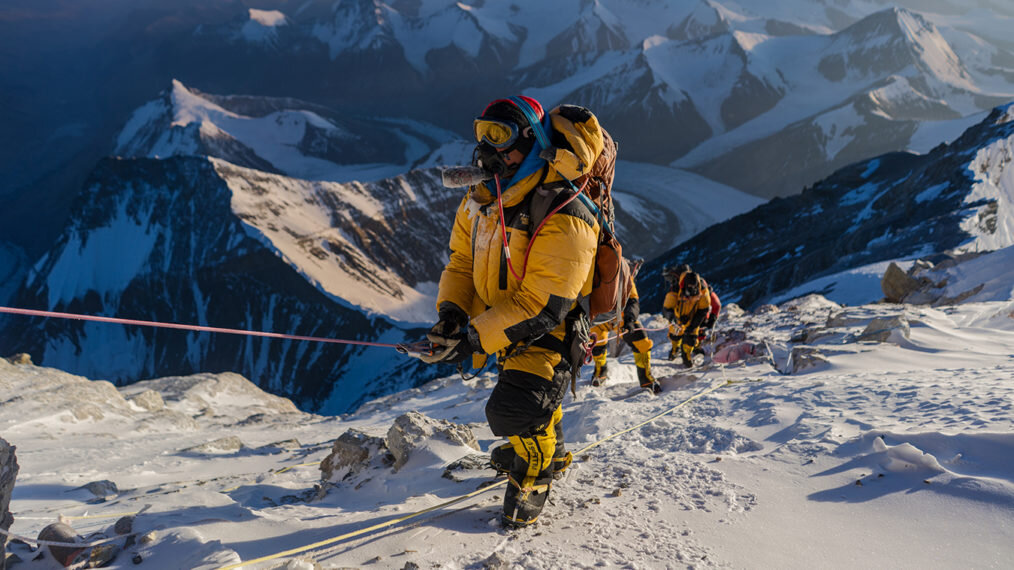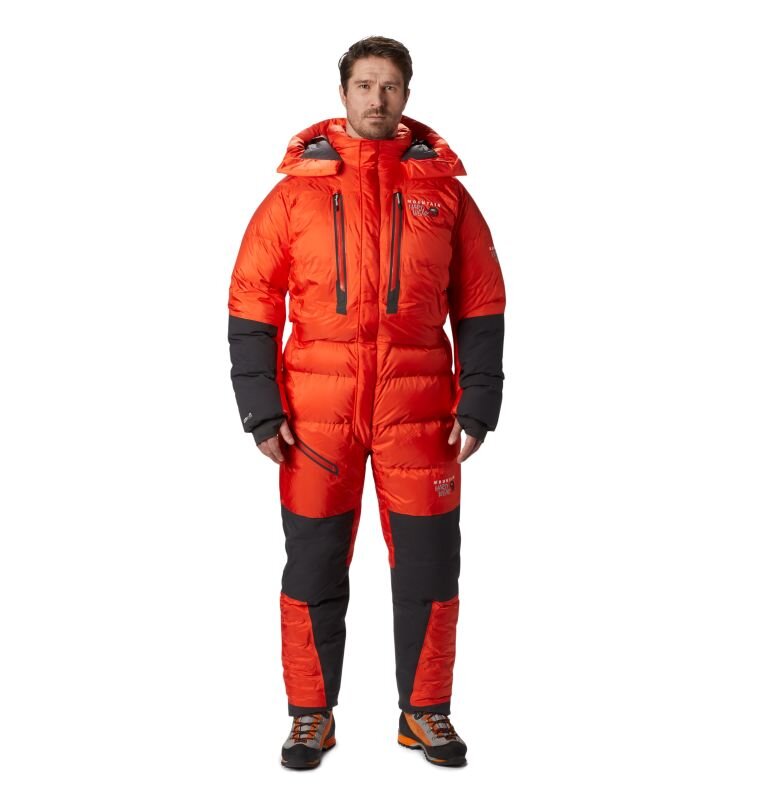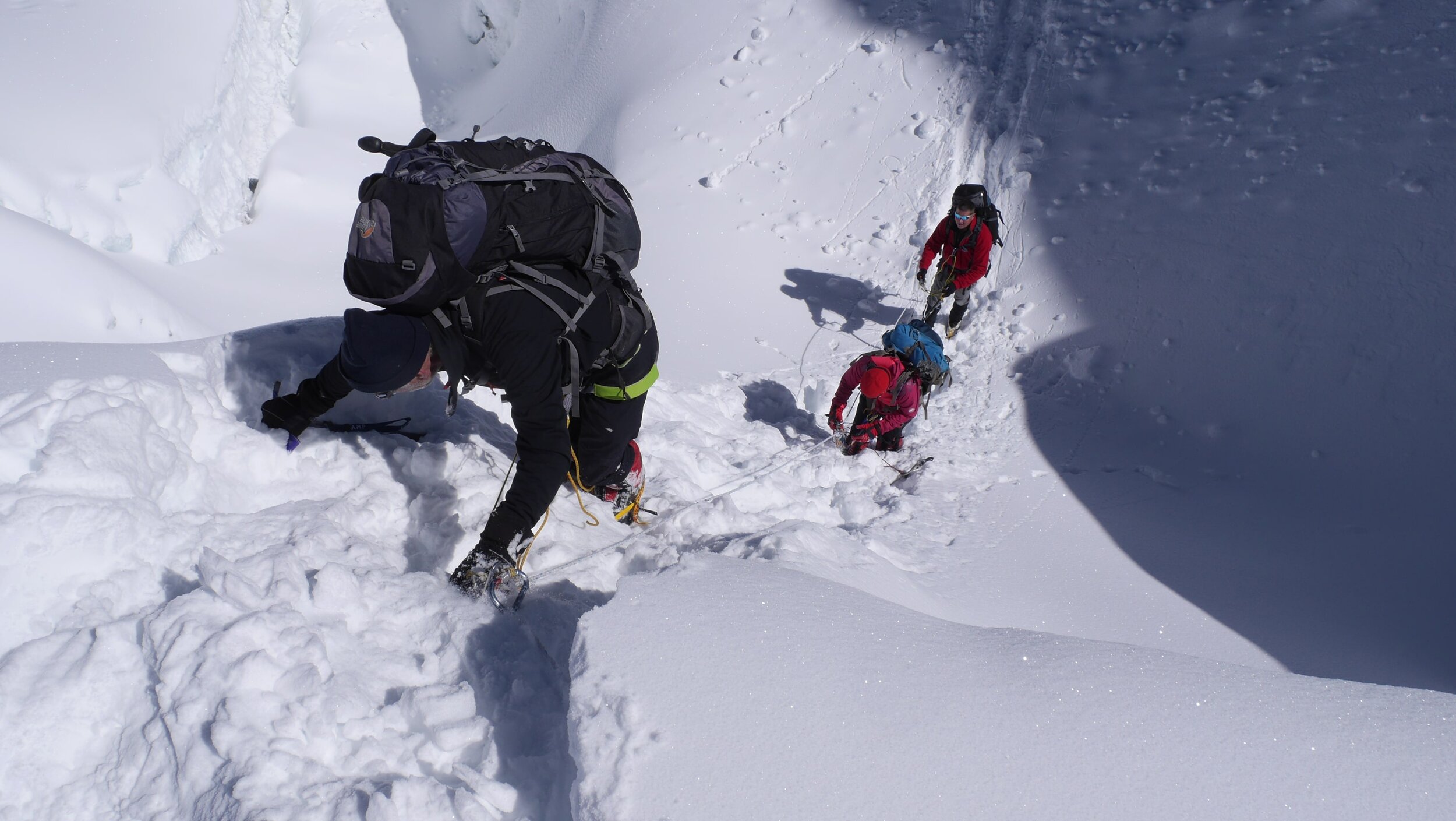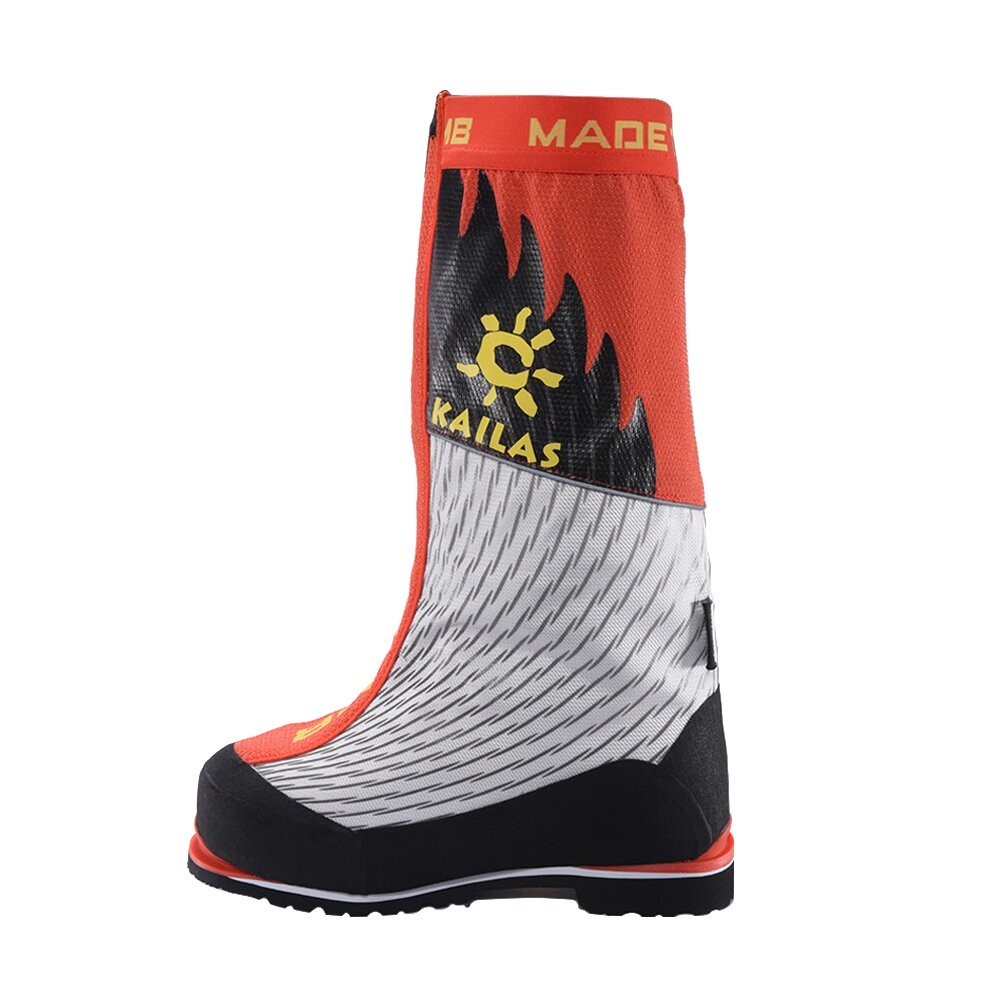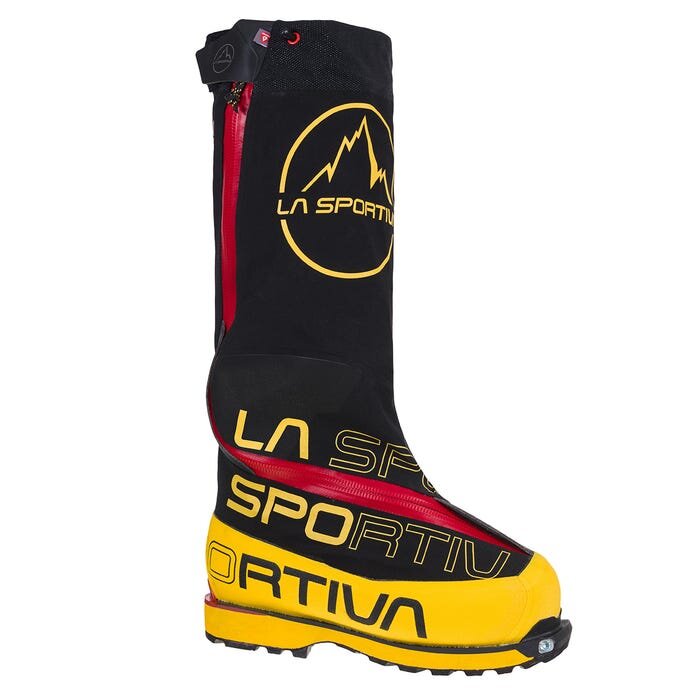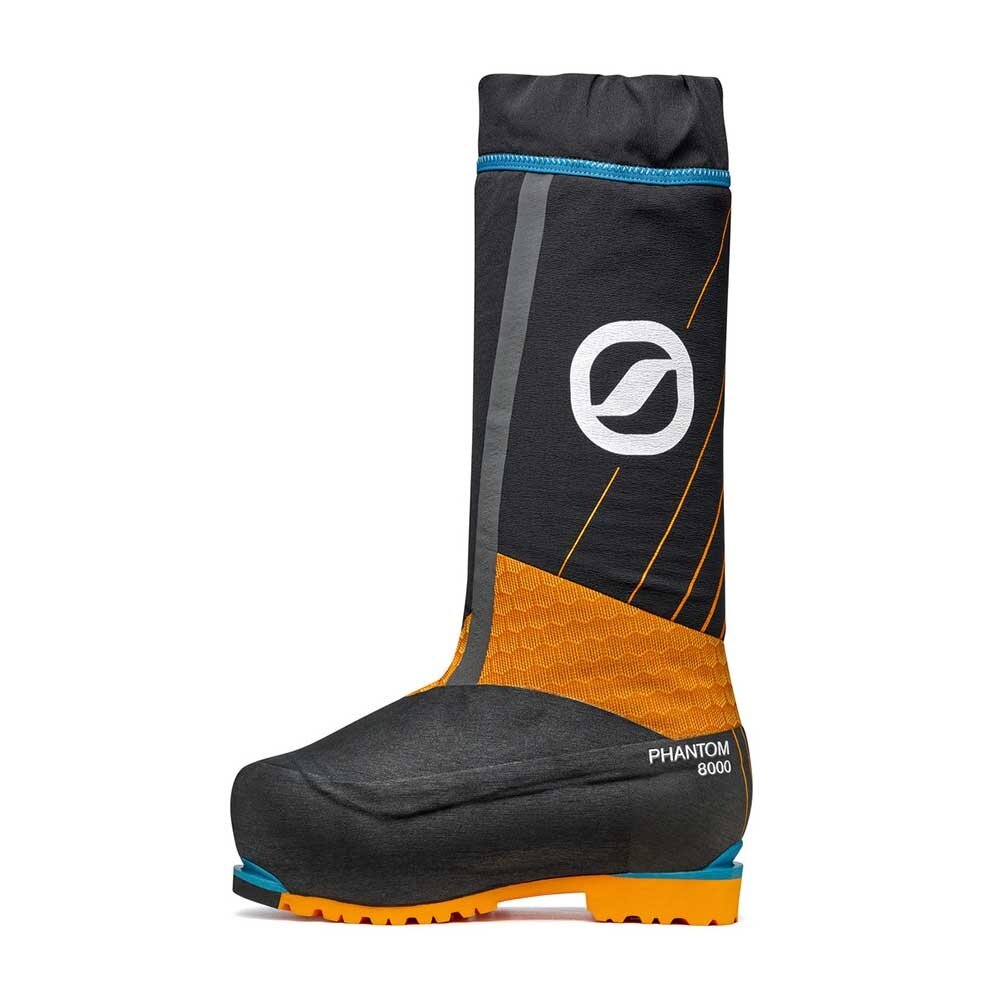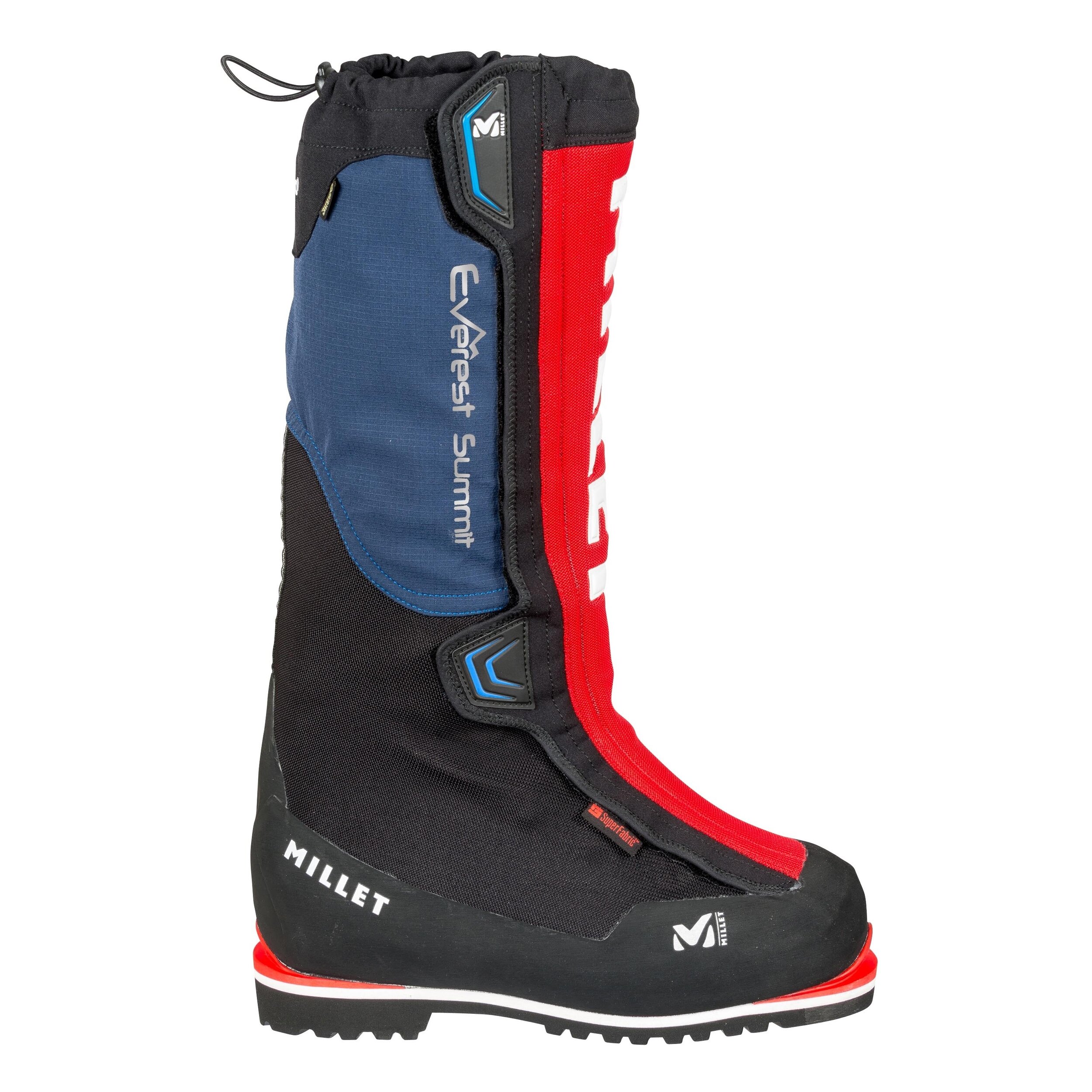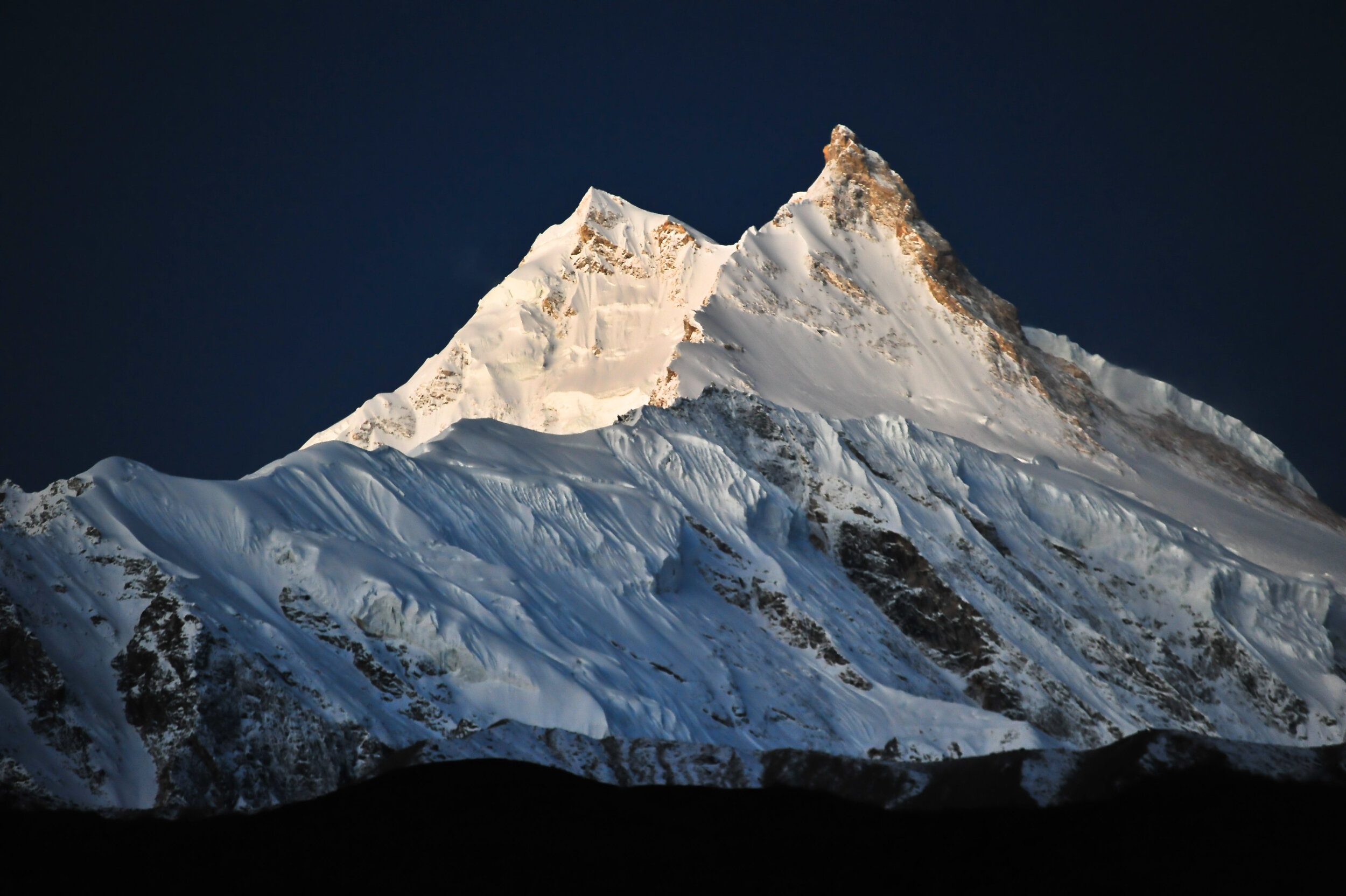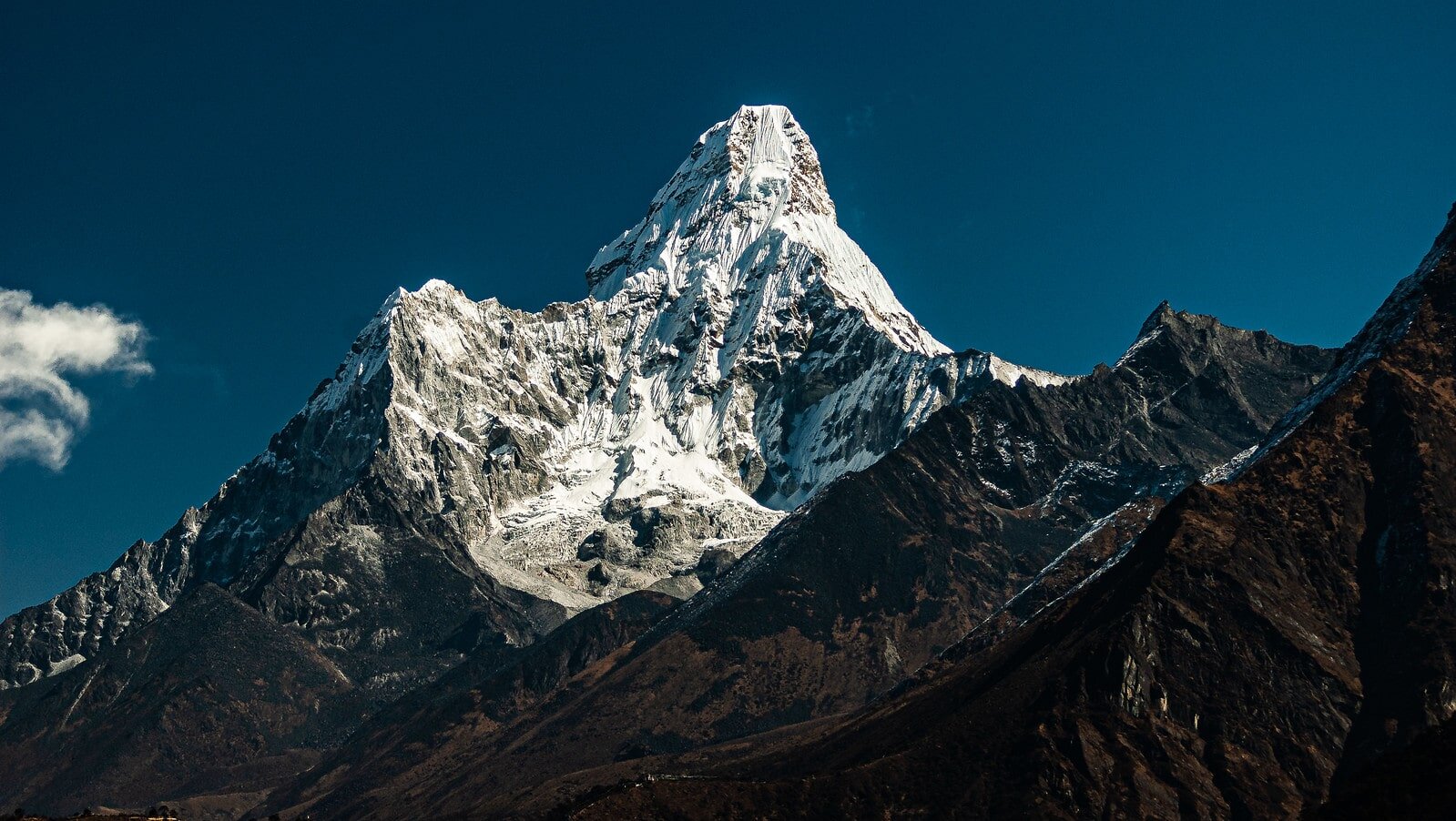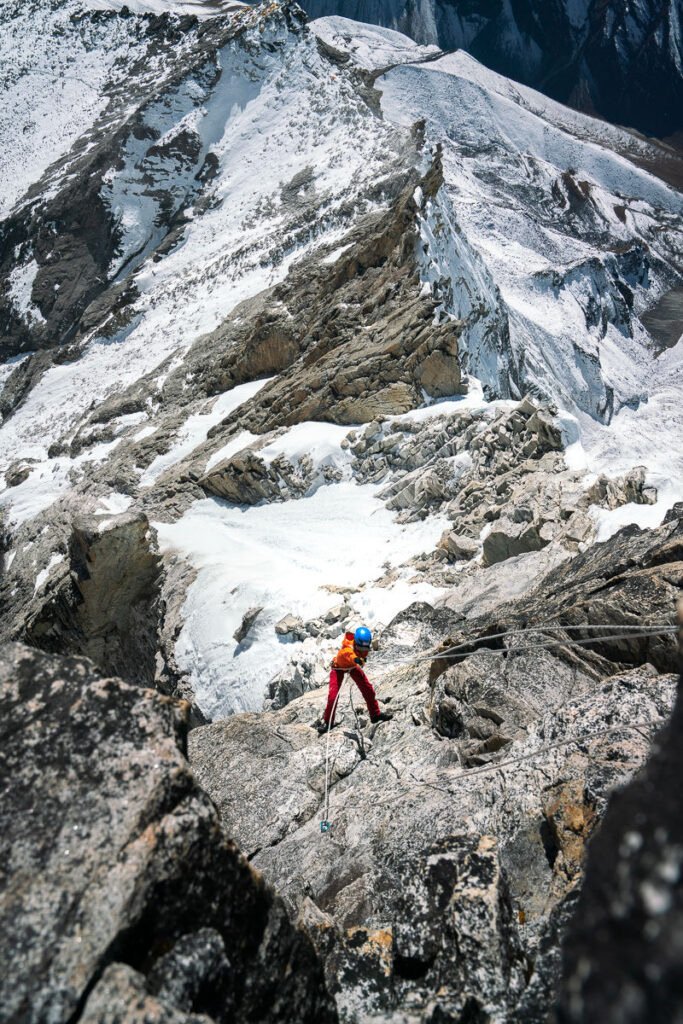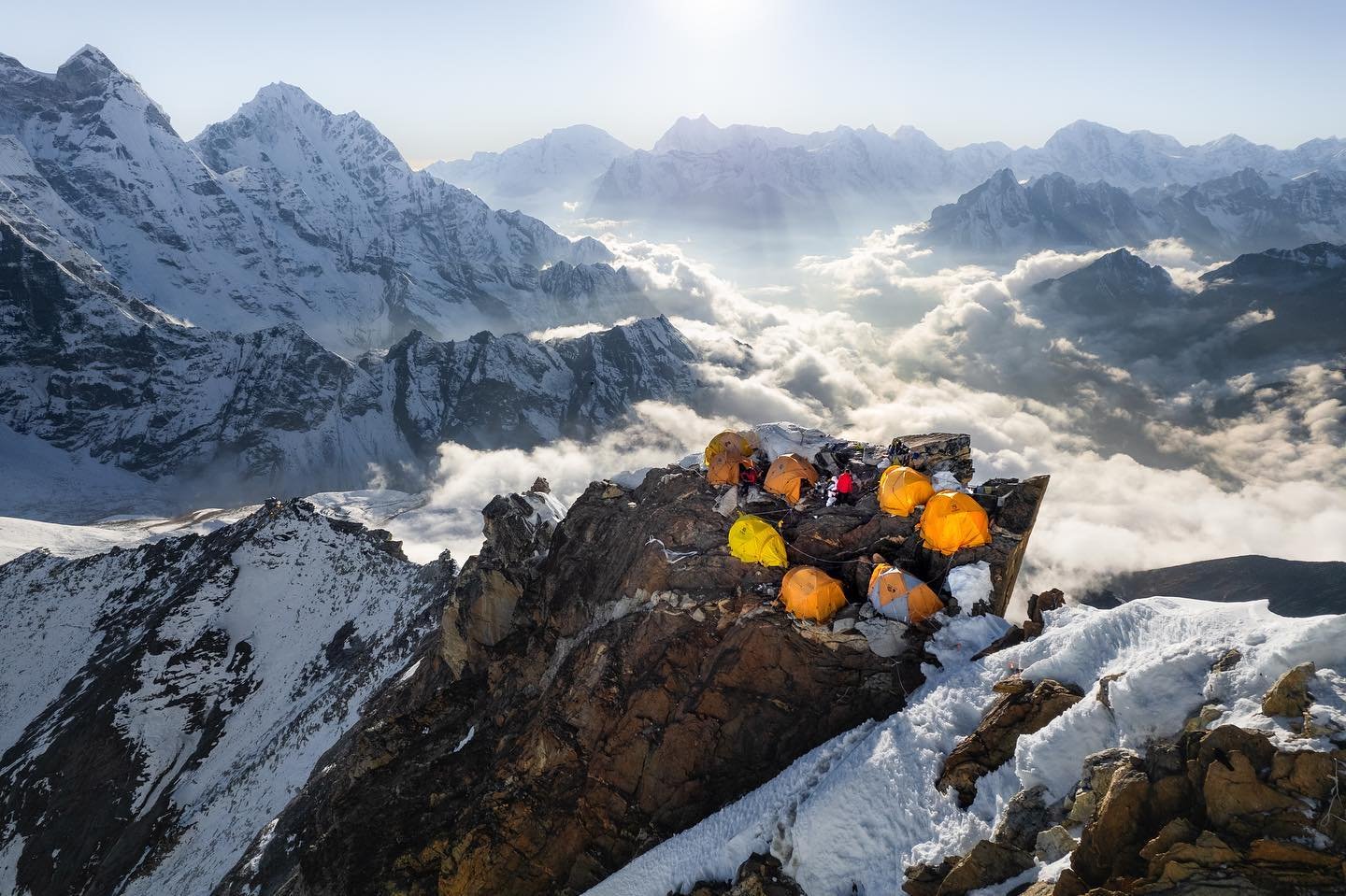2021 Best Mountaineering Down Suits - Namas Adventure
Photo by - Matt Irving / National Geographic
Down suits are probably the most visible aspect when coming across images of extreme high altitude mountaineering. They are also the must clothing gear along with other specialized clothing. But in this post, we are here to talk about down suits only. They don’t come cheap and aren't supposed to. These are highly specialized suits built to perform and protect climbers from extreme cold conditions in some of the most hostile places. On any high altitude expedition like Mt. Everest, Manaslu, Baruntse, or Ama Dablam comes with both good and extremely windy cold climbing days. Your down suit should be versatile enough to perform in both conditions. Below are some of the best down suits we can recommend for any climbers who are preparing for their 7000M - 8000M+ expeditions.
Probably the most famous and well know suit. With the brand North face which is well known for their adventure clothing products, their down suits are one of the best in the industry. North Face down suits is also worn by famous North face athletes like Renan Ozturk, Jimmy Chin, Conrad Anker. Probably because they are part of the team but also these athletes have helped the company to test and build these suits. Some of the down suit features
800 fill goose down offers superior warmth, while 700 fill goose down in the lower body provides compression resistance
Welded baffle construction eliminates cold spots and weak points that accompany needle holes
Extra-long, two-way center front double zip with full-length draft tube
Coated with durable water-repellent (DWR) finish for added water repellency
Full-leg zips finish in a horseshoe drop-seat configuration
Adjustable hood is fully baffled for reliable warmth and zero cold spots
Intuitive, sleek, and secure integrated suspender system
Korean adventure brand Black Yak is relatively new in the European market with their expedition suits. Their expedition suit is one of the most expensive almost double or even more than other leading expedition suit brands. From the high thermal efficiency to the multi-slider zippers with extended zipper pullers. Suit features
Double-stitched down chambers
performance-mapped insulation
High-tenacity 20 Denier CORDURA® fibers and CORDURA® fibers
750 goose down, 90/10 – RDS-certified
G-LOFT® synthetic insulation 120 GSM
Water protection lamination, Material mapped for performance, Stretch zone mapped for comfort
Insulated and baffled fitted hood and Auto-fitting hood
O2 set-compatible, Goggle-compatible
Windshield brim
Drought-free compression cuff
Glove/mitten fixing points
Kevlar®-reinforced seat
Kevlar®-reinforced harness/rock points
Outer snow gaiter with Kevlar® protection and gripper band
High altitude/ Expedition double boot-compatible
Hydration bladder-compatible
Kailas brand has been trusted and worn mostly by the Sherpa guides in the Himalayas. Partly because of the company supporting Sherpa climbing community in Nepal. People may lose their trust when it comes to China-made but Kailas has been specializing in mountain wears for quite some time and if the Sherpas have their full trust in them, rest assured we can be. Suit features
Fully taped seams for waterproof, windproof, and ventilation
DWR coating
Special treatment prevents down from shedding
Reinforced panels at elbows, knees, seat, and ankles
Waterproof front pockets
Low profile insulated hood with one-hand drawcord adjustment
Adjustable shoulder straps
Waterproof, breathable zippers at both sides of thigh
Oxygen-mask-compatible collar
Marmot - warm cube 8000M suit
Marmot is another well-known brand in the world of adventure. Their warm cube 8000M suit is that what you need on Icy winds, steep snow, and freezing cold conditions. When your adventures start with all of the above, you need gear that’s just as epic—and more. Marmot down Suit feature -
800-fill-power-down provides exceptional warmth, loft, and compatibility
Pertex Quantum® fabric is designed to protect from wind and improve the efficiency of insulation
Removable liner with WarmCube™ construction for ultra-comfortable warmth in extreme conditions when you need it
Adjustable suspenders with mesh back panel and front detach system for a customized fit and improved airflow
Attached hood with peripheral cord adjustment and insulated muff
4-way water-resistant center front zipper; 4-way rainbow seat zipper with stay-open hook
Dual internal mesh 1-liter water bottle pockets; Zippered hand and thigh pocket
Mountain Hardwear is another brand that holds a reputation when it comes to Hiamalayan gears and clothing. Their down suits has earned praises from many climbers. Some of the features of the suit are listed below
Q Shield™ Down: welded, watertight baffle construction
6-slider watertight rainbow rear-zip for easy on/off
Oxygen mask compatible collar
Low profile, insulated, fixed hood with one-handed drawcord for quick fit adjustments
Reinforced panels at elbows, knees, seat, and hem
90% Goose Down, 10% Goose Feather
British brand RAB is best known for specializing in their down-filled products. Down jackets for everyday lifestyle, adventures to the high Himalayan peaks. The Rab Expedition 8000 Suit has built on the best selling Rab Expedition Down Suit and has improved on an already class-leading down suit it has been designed for use in the harshest environments, specifically for use in extremely cold conditions at High Altitude and in the Polar Regions. RAB 8000M down suits features
Pertex® Endurance Outer Fabric and Pertex Quantum® Lining
850FP R.D.S. Certified European Goose Down (778g Size M)
Rab® Fluorocarbon free Hydrophobic Down developed in conjunction with Nikwax®
Box-wall construction, differential cut
Helmet Compatible down-filled Hood, wired peak
Front Zip Protection Flap
Extended LEngth YKK® front zip, 2-way zipper to allow toilet access
3 outer pockets, 2 internal mesh pockets
Full-Length YKK® side zips with multiple Pullers
Weight 1990g (size M)
Whichever suit you choose at the end the listed suits above are amongst the best in the industry. Fabrics and technology have progressed so far that it’s amazing to see how far these suits have come since the early days of the expedition. You can rest assured of the performance when it comes to its utility and then it comes down to the brand you prefer, colors, styles, sustainability values, and reviews.
Conclusion
Choose the best one that’s out there in the market. With adventure brands innovating and developing high-quality down suits you have more options now. We have listed some of the most famous down suits out there in the market today. We cannot stress this enough but quality (highest) matters. This is the last place on earth where you would not have adequate clothing gear. The game is extreme in the Himalayan altitudes so you’ll need the best of the best which are listed above.
Which mountaineering down suit will you buy for your upcoming extreme expedition? Please comment below :)
Suit up. Climb on.
Live Your Story
Everything you need to know about Himlung Himal 7126M climbing Expedition - Namas Adventure
Himlung Himal, standing at 7126 meters, is a popular and relatively safe choice for climbers looking to tackle a 7000-meter peak in Nepal. Located in the rain shadow region of mid-western Nepal, this mountain offers a semi-technical climbing route with fixed ropes available to help you reach the summit. The climbing route is mostly on ice and snow, with a steep, exposed ascent to the top. Sherpa guides from different groups often work together to set up the ropes on climbing days. If you're seeking a high-altitude climbing adventure or are looking to progress to 8000M peaks or difficult challenging peaks, Himlung Himal is a must-climb.
Overview:
Altitude: 7126M / 23,379ft
Climbers experience level: Intermediate/Advanced
Location: Annapurna Region
When to climb?: Late spring Mid April - May and September - October
Total no of days: 30 Days
Difficulty grading: AD+/4 (Alpine/Fitness grading info)
Accommodation: Lodges and Base camp, Camp 1/2/ 3(Optional)
We have listed 10 useful pieces of information that will help you prepare for your Himlung Himal peak climbing expedition.
1. When is the best time to climb Himlung Himal?
Himlung Himal is best suited to climb during the mid-spring season around mid-April to May or during the early autumn season; just towards the end of the monsoon season. End of August to the end of October.
Note - Himlung is one of the remote climbing peaks with very few teams attempting the climb every year. You can be certain there won’t be many climbers or traffic during your expedition.
2. How much does the Himlung Himal expedition cost? What does it include?
Join the Namas Adventure team for a Himlung Himal expedition at a cost of $9050 per person. Our all-inclusive peak climbing services are of the highest quality and prioritize your safety with a 1:1 guide-client ratio, several successful summits, 100% safety records, and cultural immersion. As a responsible, ethical, and sustainable mountain adventure brand, we are committed to our core values and ensuring that you can fully enjoy your climbing holiday without worrying about any logistics. With our team by your side, you can focus on the fun and adventure ahead.
List of what’s included in your booking.
IFMGA/NMA certified Guide leader
$500 Individual tip pool. Tip pool will be fairly distributed among all Namas staff members. (Guides, porters, drivers, hotel security, and staff). Guest may personally hand in extra tips to our guides and porters)
Namas Branded merchandise (Down Jacket, Cap, Buff)
1:1 Sherpa Guide /client ratio
Head chef and 2 kitchen helpers (Assistants increase with the number of climbing team members )
Arrival hotel in Kathmandu
All trekking and climbing permits (Annapurna Region Permit and TIMS)
All internal-local transportation to and from the trekking trailhead
Expedition tents (2 or 1-person tents ) Brands Salewa, Mountain Hardwear, Samaya equipment, Kailas
40 kgs personal weight
Freezed dried or meals during camping days (Chicken, mushroom, vegan options, etc)
Chocolate, biscuits, canned foods, nuts
Burners and expedition equipment
Walkie-talkie/ Satellite phone
Breakfast, Lunch, and Dinner on trek and expedition days.
Lodge accommodation during the trek
Porters per guest
Arrival pick up and departure
Internal flights
Basic First aid kit
Welcome/Farewell leave Dinner
3. What experience do climbers need to climb Himlung Himal? Are guides necessary for Himlung Himal climb?
Experiences - It is essential for climbers to have previous high-altitude alpine/mountaineering experience (at or above 3000 meters) in order to successfully climb Himlung or other 7000-meter peaks. While this experience does not necessarily need to be in Nepal, it is important for climbers to be comfortable using crampons on snow, ice, and steep surfaces, proficient in using fixed ropes to climb steep and exposed sections, and familiar with the use of climbing gear and basic rope techniques such as tying safety knots and abseiling. Mental toughness and the ability to withstand cold and windy conditions are also crucial for climbers attempting Himlung or other major expeditions in Nepal. The use of jumars and rappelling/abseiling skills will be necessary for descending the mountain, and it is important for climbers to have the strength and endurance to sustain these activities for an extended period of time.
Local Guides - According to Nepalese law, all climbers attempting peaks above 6000 meters must be accompanied by a guide. To obtain a permit for climbing Himlung Himal, it is necessary to go through a registered local company. For intermediate-level climbers, we strongly recommend hiring a guide for this peak due to the presence of crevasses and other potential hazards along the usual climbing route. However, if you are an experienced climber with many successful climbs under your belt, you may wish to explore less traveled routes. In this case, it is still a good idea to have a guide as a backup in case of unexpected challenges.
4. What is the best-acclimated itinerary for climbing Himlung Himal Expedition?
Proper acclimatization is crucial for the success and safety of high-altitude climbing trips. It allows the body to rest, adapt, and become stronger, enabling you to reach even higher elevations. At Namas Adventure, we take a slow and steady approach to high-altitude climbing, with itineraries that have been carefully crafted through our years of experience. This ensures that you are well-prepared and able to fully enjoy your adventure.
On the Himlung Himal expedition, we have established 2-3 high-altitude camps to allow climbers sufficient time to acclimatize. This helps to ensure that you are properly adapted to the high altitude and able to successfully reach the summit. Our experienced guides will help you to monitor your progress and provide guidance and support throughout the trip to help you reach your goals.
More details are on our Himlung Himal climbing strategy.
5. What training is required for Himlung Himal? Can you suggest to me a training plan?
Himlung Himal is a great mountain for anyone looking to tackle their first 7000-meter peak or a semi-technical, high-altitude expedition. It is known to be one of the easier and safer 7000-meter mountains, with a high success rate. However, it is important to note that no mountain peak is easy to climb and we do require interested climbers to have previous high-altitude experience (at or above 3000 meters) in order to participate. If you are seeking a challenging yet achievable climbing adventure, Himlung Himal may be the perfect mountain for you.
Mountains are graded based on their technical and physical difficulties. It can be difficult to simulate the specific challenges you will face on the mountain, such as crossing crevasses, in your training. However, there are some general fitness activities that can help you to build endurance, strength, and core stability. These may include long-distance running (10K - 20K), long-distance hiking (6 hours+), cycling, and hiking with a weighted backpack. We recommend scheduling your training at least 5-6 months before your climbing departure to ensure that you are in peak physical condition. More on our training mountain expedition blog.
Courses like beginner mountaineering classes are also a helpful tool. You will learn technical skills like climbing with a rope on 5/6 anchor points using ascenders, how to walk with crampons on ice, snow, and rock, and to be efficient with abseiling and overall gear safety checks awareness.
6. How hard is Himlung Himal climbing expedition?
Himlung Himal is graded at PD+ - AD/4 in difficulty. (Alpine/Fitness grading link).
It is imperative that climbers are in top physical condition before embarking on the Himlung Himal expedition. The climb will be physically and mentally demanding, with a total of 15 days of alpine climbing. Proper acclimatization, hydration, and nutrition are key to coping with the altitude and breathing challenges. The real alpine challenge begins when we depart from the base camp, also known as the French base camp, and encounter glaciers and ice surfaces on the climb. The route to the summit involves traversing some uphill, slippery sections, as well as traversing some crevasses. The campsites are located in wider sections of the mountain, reducing the risk of setting up camp on exposed cliffs. Fresh snow is also a possibility along the route. Proper training in endurance and strength should have prepared your body to handle these challenges.
7. What are the clothing and gears - boots required for Himlung Himal climb (trekking and mountaineering)? Can I rent gears for Himlung Himal climb?
The right gear is essential for a successful and comfortable climb. We recommend that climbers invest in high-quality gear and clothing, and pay attention to layering in order to stay warm in the cold temperatures that can drop as low as -10C/-20C at night. It is important not to skimp on quality, as you will be relying on your gear to keep you warm and comfortable during the climb. Please check our equipment blog for recommended clothing and gear.
Is it a good idea to rent climbing gear in Nepal? In our experience, we do not recommend it. We have tried various gear rentals in Nepal and have not been satisfied with the quality. While it may seem expensive to purchase all the necessary gear, it is worth the investment in the long run. You can also consider renting gear from reputable adventure gear companies in your own city. Gears of well-known adventure brands such as North Face, Mountain Hardware, or Kailas are recommended. Make sure to choose original products from trusted brands to ensure the best performance and safety on your climb.
Boots (trekking and mountaineering) for Himlung Himal
With better technologies, climbing shoes have improved every year. We highly recommend double-layered boots like Kailas Everest 8000M, La Sportiva Olympus Mons Cube, Scarpa 8000 phantom, Millet Everest summit GTX. It is wise to spend on good mountaineering boots, as so with all the gears that we have mentioned in this post above.
More 8000M boots link here (other media article)
8. What types of foods are available during Himlung Himal climb? Is clean water available and how much water intake is recommended? Hydration and nutrition
To ensure proper hydration, we recommend that all clients drink 4-6 liters of water per day. It is helpful to bring hydration tablets or filtration bottles. Obtaining water at higher camps can be difficult, so our team will do their best to boil snow and provide water at higher camps and during the summit push. Most meals are prepared in tea houses, and during climbing days, our Sherpa team sets up kitchen tents at the base camp. Sherpa guide members will cook quick meals at higher camps. While it can be difficult to eat enough in cold, high altitudes, it is important to try to force yourself to eat. We also provide packed dried meals as an alternative option.
It is important to avoid smoking and alcohol consumption during the Ama Dablam expedition. While it may be common to see the guiding leaders engage in these activities, they are professionals who have adapted well to high-altitude environments. As a climber on this adventure holiday, it is important to prioritize your health and well-being by abstaining from these harmful habits. Remember to also pay attention to your diet and hydration, as these will greatly affect your performance on the mountain.
9. What trip insurance will I need for Himlung Himal climb? Do I need helicopter evacuation to be included in my insurance coverage?
No matter how prepared you are, you never know when or how things might go wrong. You might be sick suddenly or not that we wish but there might be some incident, you might suffer from altitude sickness or anything we can’t imagine yet. So, for these reasons, it is always good to have insurance cover. Our recommended Insurance companies (link)
Helicopter evacuation is our final emergency option and we do recommend you have one in your insurance, as it is the only means of transport in the Everest region. Our guides will assess your condition and examine if it is a major issue. If not, they will use their experience to motivate and push you through your trip. However, in case of emergency, helicopter evacuation will be called upon.
There is a procedure to follow when calling for emergency evacuation. We will call the insurance company hotline, get approval from your insurance, and only then helicopters are sent to the distress call location. You will have to pay for the evacuation in Nepal from your own pocket but once you are back home you can claim your money back. Make sure you collect helicopter evacuation receipts and a certified doctor’s approval letter. The insurance company will ask for this evidence to back up your claim. There was a huge helicopter scam in Nepal in 2018, so insurance companies are taking extra measures to stop this from happening. Our guides and staff members in Kathmandu will also remind you of this process during briefings.
10. Next climbing goals after Himlung Himal climbing
After completing your Himlung Himal climb we would like to recommend the following challenging expeditions
1. Ama Dablam 6819M and Island Peak 6189M climbing expedition - Click here
Technically difficult and climbing goal for many mountaineers. Ama Dablam is well renowned as one of the most beautiful and exposed Himalayan mountain in the Everest region. It is one of the most sought mountains to climb by mountaineering enthusiasts. Whether you plan to do it before or after your bigger expedition like Everest, Ama Dablam climb in itself is a mountaineering challenge on its own. Ama Dablam is considered "a must-do" for alpinist and mountaineers.
2. Manaslu 8163M Expedition - Click here
Want to experience 8000M+ a death zone altitude and gain the right experience for Everest or other higher extreme altitude climb? Manaslu Expedition is for any aspiring mountaineers who are considering climbing an 8,000m peak or higher. Manaslu has to be one of the preferred options if you are looking to climb the 8000M peaks and is also a necessary option to get that 8000M experience before attempting to climb Mount Everest. The expedition begins with trek to Manaslu trails passing through the village at the foot of the mountain where then arrive at Manaslu Base Camp to begin the climb.
3. Mt. Everest 8848M Expedition, Nepal
Himlung Himal climbing expedition is one of the remote trek and climbing destinations in Nepal. As we will be able to many more expeditions down the year we believe Himlung Himal Expedition can be one of the classic mountaineering adventures at 7000M level that will be accessible and climbable for upcoming climbers. The charm of its remote location tucked away in the not-so-popular area of Nepal, beautiful trek through the Annapurna valley and nomad culture makes the whole trip experience an amazing adventure. We hope the information we have provided above will help you decide/prepare in the best way before you embark on your Himlung climbing expedition. If you are looking for a great climbing trip and have an amazing time in Nepal then we would love to have you on board for our Himlung Himal expedition. You can be assured that you are provided quality services with our fun-loving yet professional guides who have 5 - 10+ years of taking clients on such peak climbing trips. After all, we do aim to be the best adventure specialist in the world and you having a great time, being safe and summiting will always be our priority.
If you do have any more questions, please ask us below in the comment section or you can email us at bookings@namasadventure.com and our team will get back to you as soon as they can. Stay well. Challenge yourself. Dare great things and live your story.
Climb - Himlung Himal 7126M Expedition
10 important things to know about Ama Dablam climbing Expedition - Namas Adventure
Ama Dablam 6810M
Ama Dablam is known for its stunning beauty and is a highly sought-after mountain for mountaineering enthusiasts. It is considered a challenging climb on its own and is often viewed as a "must-do" for those who are interested in alpinism and mountaineering. Many people choose to tackle Ama Dablam either before or after attempting a larger expedition like climbing Mount Everest.
History: Ama Dablam was first summited on 13th March 1961, a Silver hut scientific expedition led by Sir Edmund Hillary. Ama Dablam's expedition has been a dream for many mountaineers. Its Southwest ridgeline is the safest route to climb this amazing peak.
We have listed 10 useful pieces of information that will help you prepare for your Ama Dablam peak climbing expedition.
1. When is the best time to climb Ama Dablam?
Ama Dablam is best suited to climb during three climbing seasons.
Spring (Mid-April-May) - There are hardly any climbers during the spring season solely because major expedition companies are focused on the Everest expedition. Climbers seeking fewer teams and climbers on the route are recommended to climb during spring.
and Autumn (September - November) - Autumn attracts a lot of climbers. You can expect a lot of teams climbing from Mid October - November end. November - December is less busy but a tad colder compared to peak October expedition.
Early Winter (December - January) - Winter climbs are for the extra gritty challenge seekers. This is another best time of the year when there are very few climbers and the Everest trails are quieter. Winter officially begins on 21st December. As expected be ready to brace for crispy cold and an unexpected gust of wind.
Note - Ama Dablam is the 3rd most sought technical climbing peak in the Khumbu region, with the majority of the permits being issued during the autumn season.
2. Climbing route and difficult sections, mountain grading of Ama Dablam climbing
All major commercial expeditions use the Southwest Ridge section route of the mountain. Ama Dablam expedition is graded at TD / 5 in difficulty. (Alpine / Fitness grading link).
Exposed section after Camp 2.
This expedition involves steep vertical mixed climbing on rock, ice, and snow. You must be in excellent physical and mental condition to tackle this challenging climb. Do not underestimate the difficulty of this mountain. Your previous climbing experience will help you gauge your fitness level and understand how to safely tackle the climb. With proper preparation and guidance from our team, you can achieve your dream of climbing Ama Dablam. The sheer vertical ascent of this mountain will likely be one of the toughest climbs you have ever attempted. However, the breathtaking beauty and exhilarating experience of reaching the summit make it all worth it. Are you ready to push yourself physically and mentally to reach the summit of Ama Dablam? It will surely be one of the most memorable peaks you ever climb."
Notable technical Sections at Ama Dablam climb.
Note - Your entire climb from camp 1 to the summit will be assisted by a fixed rope.
Climbing to Camp 2 “Yellow Tower”
Images by Jackson Groves / Journey Era
The route from Camp 1 to Camp 2 is one of the most technically challenging parts of the expedition. The climb to the top of Yellow tower involves a 90-degree vertical ascent. This section of the route is graded anywhere from 4.11 to 5.7 - 5.10 in rock climbing terms. It's important to consider the impact of altitude, carrying a backpack, cold weather, and ice conditions on the mountain while attempting this climb.
Mushroom Ridge 6250M (Between Camp 2 and Camp 3)
This section of the route is not for the faint-hearted, as you will need to carefully climb up and scramble on the steep rocky face of the mountain before reaching an exposed knife-edge ridge. Walk carefully across the ridge, which has 600-meter drops on both sides, before continuing your climb towards Camp 3.
3. How much does Ama Dablam expedition cost and what does it include?
The cost of the Ama Dablam and Island Peak expedition with Namas Adventure (Please click here for cost). Our team provides premium, all-inclusive services, including 1:1 climbing support, local guides who share their knowledge of culture and traditions, and a focus on safety, successful summit strategy, and top-quality base camp support. Our team is dedicated to being a responsible, ethical, and sustainable mountain adventure operator, so climbers can fully enjoy their climbing experience.
List of what’s included in your booking.
IFMGA/NMA certified Guide leader
Namas Branded merchandise (Down Jacket, Cap, Buff)
1:1 Sherpa Guide /client ratio.
Head chef and assistants ( Helpers increase with the number in climbing team members )
Arrival hotel in Kathmandu
All trekking and climbing permits (Khumbu Region Permit and TIMS)
All internal-local transportation to and from the trekking trailhead
Expedition tents (2 or 1 person tents) Brands Salewa, Mountain Hardwear, Samaya equipment, Kailas
30 kgs personal weight
Chocolate, energy bars, hydration pills, biscuits, canned foods, nuts
Burners and expedition equipment
Walkie-talkie/ Satellite phone/GPS
Breakfast, Lunch, and Dinner on trek and expedition days.
Lodge accommodation during the trek
Porters per guest
The arrival pick up and departure
Basic First aid kit
Welcome/Farewell leave Dinner
4. Are guides necessary for Ama Dablam Peak?
Climbing Ama Dablam requires a permit, which can only be obtained through a registered local company in Nepal. It is mandatory by Nepalese law to have a guide on high altitude peaks above 6,000 meters. We recommend hiring a guide for climbers of all levels, as a successful expedition requires a strong team with a proficient base camp crew and experienced, competent, and trustworthy climbing Sherpa guides.
5. Choosing the best-acclimated itinerary for climbing Ama Dablam
Proper acclimatization is crucial for success on any high-altitude climbing expedition. Our team follows the "climb high, sleep low" mantra and will conduct rotations to Camp 1 and 2 as part of our acclimatization strategy. Through our years of experience, we have carefully crafted the itinerary to ensure the best possible chance of success for your expedition.
6. How difficult is it to climb Ama Dablam? What training and skills are required?
Ama Dablam, also known as the "mountaineer's mountain," is a challenging climb that requires experience and determination to reach the summit. The route from the base camp to Camp 1 (5800 meters) involves climbing moraines and a rocky boulder uphill. The fixed line normally starts after Camp 1, where the climb becomes more technical. The climb to Camp 2, located on top of the Yellow Tower, is the first crux of the climb, requiring a 60-70 foot vertical granite ascent at 20,000 feet. The mushroom ridge from Camp 2 to Camp 3 is another challenge, and Camp 3 is only set up once the guide leader determines it is safe. From Camp 3, climbers head up the pyramid to the summit, which involves an exposed climb on 55-65 degree slopes. The descent is difficult, especially on tired legs, and requires careful focus.
Training for Ama Dablam
To prepare for this challenging climb, it is important to focus on endurance, core, and strength training. This will help you to handle the vertical sections of the ascent, such as the "Yellow Tower" on the way to Camp 2. Suggested training activities include long-distance running, cycling, and hiking with added weight. It is recommended to begin training at least 12 weeks in advance of your climbing departure. More on our training mountain expedition blog.
Skills
Additionally, taking advanced mountaineering classes can be helpful in learning technical skills like rope climbing and proper use of gear. For the Ama Dablam climb, it is recommended to be comfortable with multi-pitch climbs up to a grade of 5.10 a,b,c and to have experience with mixed climbing. Ice climbing skills up to WI-3 or WI-4 are recommended for spring climbs, although fixed-line ropes will be used for the steeper sections of the mountain.
You should be proficient with the above-mentioned mountaineering skills, climbing with ice axe support and abseiling independently in exposed mountain terrain. Be ready for a long descent when coming down from the summit. This is particularly where most of the incidents occur during this expedition. A few accidents did occur on this route when the climber did not properly attach the safety rope to the main fixed line when abseiling down the mountain.
Ama Dablam's climbing should not be taken lightly. By no means is the peak an easy climb and we require interested climbers to have a previous high altitude of several 4000M+ to 6000M+ technical climbing experience anywhere in the world. You have to be in your best physical fitness shape. All mountain expeditions are graded based on their technical and physical difficulties. Successfully accomplishing the Ama Dablam expedition is a mixture of teams, skills, the right experiences, fitness, mental strength, weather, and other detailed mountain-climbing factors.
7. Right clothing, gear, and boots (trekking and mountaineering)? Rental options for Ama Dablam climbing?
Choosing the right gear is very important. We advise climbers not to make compromises on the quality of gear and clothing, and to pay attention to layer up comfortably as well. You will depend highly on your clothes to keep you warm enough for the dropping temperatures at nighttime which can go down to -10c /-20c. Please check our equipment blog for recommended clothing and gear.
Renting your gear in Nepal? The simple answer is NO. This is one of the most frequently asked questions mainly by beginner climbers. We have tested and tried several gears in Nepal and frankly, we do not recommend hiring here. We know it might seem like a huge amount of expense to buy all the gear, but they are well worth it. You can even hire from the city you live in. Make sure they are original products from well-known adventure gear companies. (North face, Mountain hardware, Kailas, etc.)
Boots (trekking and mountaineering) for Ama Dablam climb
With better technologies, climbing shoes have improved every year. We highly recommend double-layered boots like Kailas Everest 8000M, La Sportiva Olympus Mons Cube, Scarpa 8000 phantom, and Millet Everest summit GTX. It is wise to spend on good mountaineering boots, as so with all the gears that we have mentioned in this post above.
More 8000M boots link here (other media article)
8. Hydration and nutrition
To ensure proper hydration, we recommend that all clients drink 4-6 liters of water per day. It is helpful to bring hydration tablets or filtration bottles. Obtaining water at higher camps can be difficult, so our team will do their best to boil snow and provide water at higher camps and during the summit push. Most meals are prepared in tea houses, and during climbing days, our Sherpa team sets up kitchen tents. While it can be difficult to eat enough in cold, high altitudes, it is important to try to force yourself to eat. We also provide packed dried meals as an alternative option.
It is important to avoid smoking and alcohol consumption during the Ama Dablam expedition. While it may be common to see the guiding leaders engage in these activities, they are professionals who have adapted well to high altitude environments. As a climber on this adventure holiday, it is important to prioritize your health and well-being by abstaining from these harmful habits. Remember to also pay attention to your diet and hydration, as these will greatly affect your performance on the mountain.
9. Insurance and Helicopter evacuation for Ama Dablam Expedition
No matter how prepared you are, you never know when or how things might go wrong. You might be sick suddenly or not that we wish but there might be some incident, you might suffer from altitude sickness or anything we can’t imagine yet. So, for these reasons, it is always good to have insurance coverage. Our recommended Insurance companies (link)
Helicopter evacuation is our final emergency option and we do recommend you have one in your insurance, as it is the only means of transport in the Everest region. Our guides will assess your condition and examine if it is a major issue. If not, they will use their experience to motivate and push you through your trip. However, in case of emergency, helicopter evacuation will be called upon.
There is a procedure to follow when calling for emergency evacuation. We will call the insurance company hotline, get approval from your insurance, and only then helicopters are sent to the distress call location. You will have to pay for the evacuation in Nepal from your own pocket but once you are back home you can claim your money back. Make sure you collect helicopter evacuation receipts, a certified doctor’s approval letter. The insurance company will ask for this evidence to back up your claim. There was a huge helicopter scam in Nepal in 2018, so insurance companies are taking extra measures to stop this from happening. Our guides and staff members in Kathmandu will also remind you of this process during briefings.
10. Next climbing goals after Ama Dablam climbing
It is only natural that as a climber, you would want to climb higher, more challenging peaks. Once you have successfully completed Ama Dablam, consider yourself one of the capable mountaineers. Climbers know that summiting Ama Dablam is no easy feat, so you should be able to take on even higher peaks, such as those over 8,000 meters, after this climb.
Mt. Everest Expedition 8848M
Manaslu Expedition
Annapurna IV 7525M
k2 8611m Expedition
A successful Ama Dablam climbs with a strong yet fun environment expedition team, proper training, and planning before the expedition is possible. These are the things that are within your control. As we have stressed enough Ama Dablam climb is not an easy one and you will have to get every aspect right so that you have a better chance of completing your expeditions and have a great time. Join our fun-loving yet providing the best service and safety team on our yearly Ama Dablam Expedition. Our team would love to have you on board and make your dream of climbing Ama Dablam a success.
Ama Dablam Expedition - Click here
If you do have any more questions, please ask us below in the comment section or you can email us at bookings@namasadventure.com and our team will get back to you as soon as they can. Stay well.
Challenge yourself. Dare great things and live your story.
Everything you need to know about Baruntse Peak climbing Expedition - Namas Adventure
Baruntse Peak 7129M is one of the accessible 7000M+ climbing peaks in Nepal. Sitting just between the world’s highest peak Mt.Everest and Makalu, this expedition will give you a glimpse and scale of the surrounding 8000M+ mountain peaks. Most climbing is done via the southeast ridge, semi-technical in technicality where the guiding team will have fixed the rope all the way to the summit. During climbing days, local Sherpa guides leaders from several teams colloborate together to set up the ropes. The climbing route is mostly on ice and snowy surfaces with an exposed section past 6600M+ all the way to the summit. This is definitely a must climb for any climbers seeking high-altitude climbing adventure or progress to 8000M+.
We have listed 10 useful pieces of information that will help you prepare for your Baruntse peak climbing expedition.
1. When is the best time to climb Baruntse Peak?
Baruntse Peak is best suited to climb during two climbing seasons. Autumn (September - November).
Note - Mount Baruntse is one of the remote climbing peaks with very few teams attempting the climb every year. You can be certain there won’t be many climbers or traffic during your expedition.
2. How much does the Baruntse Peak expedition cost? What does it include?
Please visit our Baruntse page for the updated yearly costs [link]. With a 1:1 guide-client ratio, our team is dedicated to ensuring your safety, successful summit, enriching cultural experiences, and overall enjoyment of the trip. As a company, we uphold our core values of responsibility, ethics, and sustainability in all our mountain adventure activities. With us, climbers can be confident that every detail is handled, allowing them to fully immerse themselves in their climbing holiday and the enjoyable experiences that await.
List of what’s included in your booking.
IFMGA or NNMGA certified Guide leader
Namas Branded merchandise (Down Jacket, Cap, Buff)
1:1 Sherpa/client ratio
Helicopter flight back to Lukla from Baruntse BC after returning to BC
Head chef and 2 kitchen helpers ( Helpers increase with the numbers in climbing team members )
Arrival hotel in Kathmandu
All trekking and climbing permits (Khumbu Region Permit and TIMS)
All internal-local transportation to and from the trekking trailhead
Expedition tents (2 or 1 person tents) Brands Salewa, Mountain Hardwear, Samaya equipment, Kailas
30 kgs personal weight
Freezed dried meals during camping days (Chicken, mushroom, vegan options etc)
Chocolate, energy bars, hydration pills, biscuits, canned foods, nuts
Burners and expedition equipment
Walkie talkie/ Satellite phone and GPS
Breakfast, Lunch, and Dinner on trek and expedition days.
Lodge accommodation during the trek
Porters per guest
Arrival pick up and departure
Internal flights
Basic First aid kit
Welcome/Farewell leave Dinner
3. What experience do climbers need to climb Baruntse? Are guides necessary for Baruntse Peak?
Experiences - Previous high altitude (3000M - 6000M+) alpine/mountaineering climbing experiences are absolutely necessary in order to climb Mount Baruntse or other 7000M+ peaks. It necessarily doesn’t have to be in Nepal but can be anywhere else in the world. Climbers need to have good knowledge and experience in hiking/climbing using crampons on snow, ice, and steep surfaces. Must be comfortable and proficient in using a fixed rope to climb on steep and exposed sections. Climbers should be familiar with the use of climbing gears, and basic rope techniques like tying safety knots, and abseiling when coming down from the mountains, and have the mental toughness to climb in cold and windy conditions.
Local Guides - By Nepalese law, when issuing permits for high altitude peaks above 6000M+ guides are a must. To issue a permit for Baruntse Peak climbing it will have to go through a registered local company. For intermediate experience level climbers, we highly suggest climbing the peak with guides. The usual climbing route does have a crevasse and there can be other danger points along the unexplored routes. However, if you are one of the experienced climbers with tons of climbing routes under your belt then there can be several routes that even local guides may not be able to climb. So even if you climbers want to explore new routes then taking a guide as a backup option would be a wise choice.
4. What is the best-acclimated itinerary for climbing Baruntse?
Amphu Lhbatsa Pass 5840M (Namas Adventure)
Climbing up Amphu Lapcha pass will get our members warmed up with Jumaring and scramble/traverse the rocky section of the mountain. Gaining an altitude of 5840M will help climbers further acclimatize before we set off to Baruntse BC 5400M.
Mera Peak climbing (6,476 M) is another alternative to acclimatize and before we head onto Baruntse. The route itself is a very non-technical, steep climb on the ice and snowy surface. Mera mountain is classed as a trekking and climbing peak.
Over the years, we have learned to avoid using Mera Peak as our acclimatization peak because our climbers often become fatigued from the climb. This fatigue has led to difficulty in recovering fully, which affects their performance on the subsequent Baruntse expedition.
5. What training is required for Baruntse Peak? Can you suggest to me a training plan?
Baruntse 7129M expedition, is by no means an easy climb and we require interested climbers to have a previous high altitude of at least (4000M - 6000M) climbing anywhere in the world. Mountains are graded based on their technical and physical difficulties. For your training, it is very hard to mimic walking on ladders like the ones you will come across when crossing the crevasse. We highly recommend focusing on endurance, core, and strength training. Any type of aerobic exercise, like long-distance running (10-20km) 3 to 4 times a week, cycling (1 hour - 2 hours), hiking gaining elevation with 15-20kgs weights are some of the suggested training. We also advise clients to mix strength and muscle endurance training when climbing this peak. Kettlebell routines or cross-fit training are recommended. We advise you to schedule your training at least 5-6 months before your climbing departure. More on our training mountain expedition blog.
Courses like beginner mountaineering classes are also a helpful tool. You will learn technical skills like climbing with a rope on 5/6 anchor points using ascenders, how to walk with crampons on ice, snow, and rock, and to be efficient with abseiling and overall gear safety checks awareness.
6. How hard is Baruntse Peak climbing expedition?
Baruntse expedition is graded at AD+ \ 4 in difficulty. (Alpine / Fitness grading link).
We cannot stress it enough, but it is very important climbers are mountain fit and strong before starting the expedition. In total, we will have 15 days of alpine climbing days and the climb will demand every ounce of your fitness and awareness. Breathing is challenging but with proper acclimatization done ahead of time and by staying well-hydrated and consuming enough nutrition, you should be able to cope with the altitude.
7. What are the clothing and gears - boots required for Baruntse Peak climb (trekking and mountaineering)? Can I rent gears for Baruntse Peak climb?
Choosing the right gear is very important. We advise climbers not to make compromises on the quality of gears and clothing, and to pay attention to layer up comfortably as well. You will depend highly on your clothes to keep you warm enough for the dropping temperatures at nighttime which can go down to -10c /-20c. Please check our equipment blog for recommended clothing and gear.
Renting your gear in Nepal? You can hire these gear from our team in Nepal. (link)
Boots (trekking and mountaineering) for Baruntse Peak
With better technologies, climbing shoes have improved every year. We highly recommend double-layered boots like Kailas Everest 8000M, La Sportiva Olympus Mons Cube, Scarpa 8000 phantom, Millet Everest summit GTX. It is wise to spend on good mountaineering boots, as so with all the gears that we have mentioned in this post above.
More 8000M boots link here (other media article)
8. What types of foods are available during Baruntse Peak climb? Is clean water available and how much water intake is recommended? Hydration and nutrition
We suggest all our clients to drink 4-6 l of water every day. Staying hydrated will also help you with acclimatizing properly. It’s best to take hydration tablets or filtration bottles with you.
Most of the foods are prepared in the tea houses and during your climbing days, kitchen tents are set up by our Sherpa teams. You do not need to worry about food but remember to eat enough. In high altitudes, although the weather is extremely cold, your body will naturally want to reject food or avoid using energy on anything, which includes eating too. You might have to force yourself with the first couple of bites and then eventually your body will start accepting the food. We also provide packed dried meals, so that clients have other options should they not want to eat what’s being cooked in the tents.
Remember to avoid smoking and any alcohol intake. You might see our guiding leaders smoking or drinking but remember they are professionals and they have adapted very well to these environments compared to the climbers who go there just for adventure holidays.
9. What trip insurance will I need for Baruntse Peak climb? Do I need helicopter evacuation to be included in my insurance coverage?
No matter how prepared you are, you never know when or how things might go wrong. You might be sick suddenly or not that we wish but there might be some incident, you might suffer from altitude sickness or anything we can’t imagine yet. So, for these reasons, it is always good to have insurance coverage. Our recommended Insurance companies (link)
Helicopter evacuation is our final emergency option and we do recommend you have one in your insurance, as it is the only means of transport in the Everest region. Our guides will assess your condition and examine if it is a major issue. If not, they will use their experience to motivate and push you through your trip. However, in case of emergency, helicopter evacuation will be called upon.
There is a procedure to follow when calling for emergency evacuation. We will call the insurance company hotline, get approval from your insurance, and only then helicopters are sent to the distress call location. You will have to pay for the evacuation in Nepal from your own pocket but once you are back home you can claim your money back. Make sure you collect helicopter evacuation receipts, a certified doctor’s approval letter. The insurance company will ask for this evidence to back up your claim. There was a huge helicopter scam in Nepal in 2018, so insurance companies are taking extra measures to stop this from happening. Our guides and staff members in Kathmandu will also remind you of this process during briefings.
10. Next climbing goals after Baruntse peak climbing
We can make following recommendations
1. Ama Dablam 6819M and Island Peak 6189M climbing expedition - Click here
Technically difficult and climbing goal for many mountaineers. Ama Dablam is well renowned as one of the most beautiful and exposed Himalayan mountain in the Everest region. It is one of the most sought mountains to climb by mountaineering enthusiasts. Whether you plan to do it before or after your bigger expedition like Everest, Ama Dablam climb in itself is a mountaineering challenge on its own. Ama Dablam is considered "a must-do" for alpinist and mountaineers.
2. Manaslu 8163M Expedition - Click here
Want to experience 8000M+ a death zone altitude and gain the right experience for Everest or other higher extreme altitude climb? Manaslu Expedition is for any aspiring mountaineers who are considering climbing an 8,000m peak or higher. Manaslu has to be one of the preferred options if you are looking to climb the 8000M peaks and is also a necessary option to get that 8000M experience before attempting to climb Mount Everest. The expedition begins with trek to Manaslu trails passing through the village at the foot of the mountain where then arrive at Manaslu Base Camp to begin the climb.
3. Annapurna IV 7525M, Nepal
Baruntse Peak climbing expedition is one of the exciting mountain climbing expeditions in Nepal. We hope the information we have provided above will help you decide/prepare in the best way before you embark on your Baruntse Peak climbing expedition. If you are looking for a great climbing trip and have an amazing time in Nepal then we would love to have you on board for our Baruntse Peak Peak climbing trip. You can be assured that you are provided quality services with our fun-loving yet professional guides who have 5 - 10+ years of taking clients on such peak climbing trips. After all, we do aim to be the best adventure specialist in the world and you having a great time, being safe and summiting will always be our priority.
Climb - Baruntse 7129M with Mera Peak 6476M link
If you do have any more questions, please ask us below in the comment section or you can email us at bookings@namasadventure.com and our team will get back to you as soon as they can. Stay well.
Challenge yourself. Dare great things and live your story.


